
18 minute read
Engulfed: Alumni Report Pandemic Challenges
Dr. Loy Anderson, herself a survivor of COVID-19, reports that while a healthy lifestyle may mitigate the severity of this virus, it does not guarantee immunity. In fact, several of her own patients were hospitalized with the disease.
Engulfed! A World in Crisis
Advertisement
Photo by Callie Brown Reports from Burman alumni describe how dealing with a massive pandemic has affected their professions and their workplaces
From Great Falls, Montana, Loy Anderson writes,
COVID-19, the disease caused by the novel SARS-CoV-2 virus, is certainly very real and has affected us all, some in small and some in very big ways. One of the most devastating effects (aside from those caused by a faltering economy) is the disease’s effect on people’s mental health, largely due to fear, helplessness, and isolation.
I by no means consider myself an expert on COVID-19. Even the best infectious disease, virology, critical care, and epidemiology experts continue to learn more about this pernicious virus. So I will share just a few things I know for sure. I know for sure it is not a hoax, a terrorist attack, or a political ploy— though it has certainly been adopted by all kinds of groups for political reasons. I know for sure that most people are recovering, and that most people who are dying from COVID-19 have at least one if not more underlying chronic health condition. And I know for sure that the only true defense is a strong and healthy immune system.
It therefore stands to reason that, if nothing else, COVID-19 should be a wake-up call for the need to optimize one’s health—not just to lower the risks of contracting or even dying from it, but to lower the risks of a host of other chronic lifestyle-related diseases as well. Yet at least two out of three people in the United States, where I practice, have one or more chronic health conditions.
My mission is to help people discover any underlying problems.
Infectious diseases can spread with extreme rapidity, threatening the health and lives of regional communities or global populations.

Editor’s Note: The news is grim. Here’s a small sampling: Refrigerated trucks, converted to serve as temporary morgues, are pulled up beside hospitals. Hundreds of thousands of families world-wide are in mourning. People are out of work; companies are fighting to survive. Schools and universities struggle to transition from face-to-face instruction to online learning. And Florida police report they are using helicopters to stop “COVID parties” where people apparently mingle to try to spread the virus.
Because our society has experienced so many changes in response to COVID-19, we asked five alumni how the pandemic has shaped their professional practices.
Loy Anderson, MD
Thriven Functional Medicine Clinic
I teach my patients how to support and nourish their minds, bodies, and spirits so they can heal. I show them how to improve and optimize the immune system, which, by very definition, God gave to defend and protect us, allowing us to go forth in the world with boldness and confidence.
One of my favorite Bible verses says, “For God has not given us a spirit of fear and timidity, but of power, love and self-discipline.” II Timothy 1:7
I believe our health is our most precious resource, and our best tool for living a life of freedom and confidence, one that is pleasing to our Creator.

Sheldon Thunstrom, MAIS, CCP no longer gather in labs to develop Professor of Paramedicine essential skills. and also with those that are symptomatic, but unconfirmed. All are automatically assigned to isolation units to protect staff and other detainees.
Professor Thunstrom reflects,
The measures put in place by governments in the early onset of the virus were severe as we simply did not know much about this new threat. This pandemic has affected not only the practice of my profession, but also the preparation of future practitioners.
The post-secondary education model in most technical colleges and polytechnic schools brings people together to collaborate, share knowledge, develop new skills, and gain an education which has handson applications. With the onset of COVID-19, this model has been upended. Students and faculty can Like other schools of higher
As front-line workers during the education in Alberta, SAIT COVID-19 pandemic, paramedics transitioned to an online teaching are extremely vulnerable to this very model. This model allowed faculty contagious virus. Sheldon Thunstrom, to continue working with students. MAIS, CCP, All were quick to has taught adapt, and current paramedicine students could at the Southern attend the theory Alberta Institute of portion of the Technology (SAIT) program in either for 18 years. a synchronous or
He is also an an asynchronous active paramedic format. with the Calgary Our transition Police Service solved the problem as a critical care of delivering the paramedic with the theory portion. Arrest Processing Unit where he Training was difficult without protective gear, but harder now with PPE. However, teaching essential skills runs a clinic for and facilitating arrestees. In that position, he has practicums—all requiring in-person worked with COVID-positive patients instruction—presented challenges. required competencies for graduation.
Our paramedic students, like many other front-line health care workers, expressed concerns over exposure to the coronavirus without having adequate personal protective gear available. Their stress was exacerbated by rapidly changing requirements as we learned more about the virus.
Providing care to patients in immediate need is stressful under the best of circumstances. The added stress of uncertainty over the pandemic added a new dynamic. Consequently, we now offer mental health support to enable student learning.
As we move forward to reopening the program at SAIT, we anticipate that post-secondary education will not look the same as it did pre-pandemic. Students’ perceptions and fears will have to be addressed, and we will have to consider new and creative ways to deliver the knowledge and

A simple way to know the difference between an epidemic and a pandemic is to remember the “P” in pandemic, which means a pandemic has a passport. A pandemic is an epidemic that travels.
competencies for students to succeed.
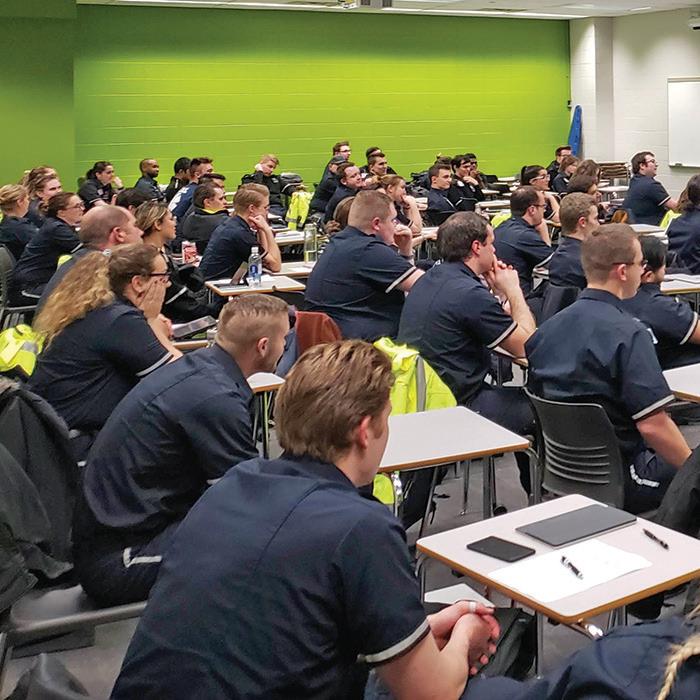
We worked with Alberta Health At the same time, we need to be Services, the primary employer for mindful of proper social distancing, the healthcare workers in Alberta. They use of personal protective equipment, authorized student practicum and the proper cleaning of labs and placements because classrooms so that the potential need a high-quality, for more front-line safe education can healthcare workers continue to be was a possibility, available to both even early in the current and future pandemic. Teaching students. the skills that Our society students had not will continue to yet acquired was depend on capable, postponed until well-prepared, the fall semester. and professional By then, we hoped, paramedicsstudents could be perhaps now more brought back to Classroom scenes such as this are no than ever. campus in smaller longer possible with the social distancing groups to gain the requirements imposed by the pandemic.
Karen (Krause) Dunbar, MA, PASC
Teacher, Magnolia Academy
Karen Dunbar has a diverse background in education. She has taught in public and private schools in multi-grade, single-grade, alternative education, and independent study settings, K-12. In addition, Karen has held appointments as adjunct professor for education departments at both colleges and universities. Her administrative experience includes teacher supervision as well as curriculum planning.
For the past two years, Karen has worked in Riverside, California, at Magnolia Academy, one of the Springs Charter Schools. Springs believes in parents’ rights to be engaged in their children’s education. So a personalized learning plan (PLP) that meets California’s standards for students becomes a collaborative project, involving parents, students, and
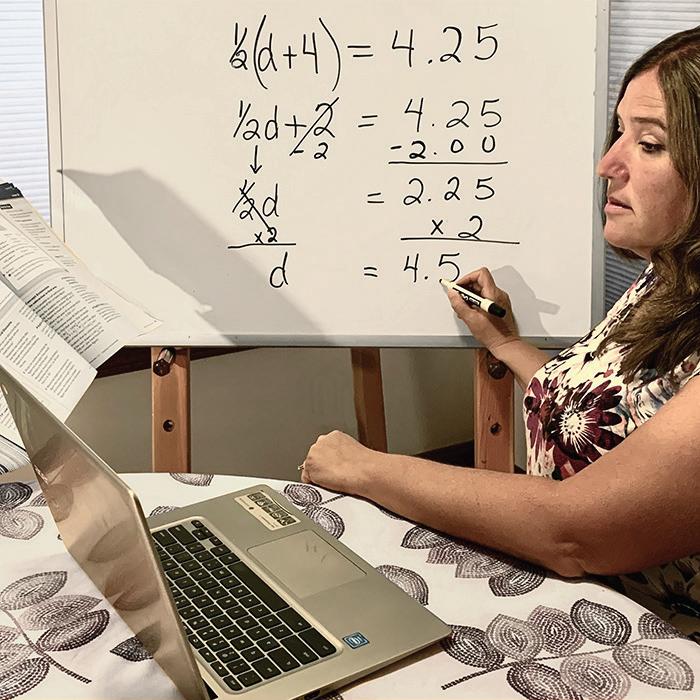
First, teachers at Magnolia Academy Finally, students were already were already working closely together familiar with checking in for online in teams. I was Photo by Austin Dunbar assignments to teaching seventh complete during grade students each Monday’s science, math, and home study session. physical education. As we transitioned My partner teacher to total online was teaching them learning, the school language arts and provided each social studies. family with at least Together we had one computer. met with parents Of course we and their children had challenges. to create a PLP Most serious for each student. Then, throughout Finding a quiet corner for teaching at home can be quite challenging. was the lack of experience with the year, we had new platforms checked in with each other regularly and programs. Issues with student to ensure that academic, social, and attendance, online etiquette, and emotional goals were being met. technology connection also emerged.
When COVID-19 hit, we took this As expected, some of the online same team approach to create student platforms were new to students. So my schedules for synchronous instruction partner and I spent time reviewing and from 8:30 a.m. to 2:00 p.m. As we met teaching both parents and students how

More than 200 countries and territories have been affected by COVID-19, with major outbreaks occurring in central China, Iran, Western Europe, and the United States.
teachers. Each Monday, parents work with students, several parents with their children at home to meet checked in as well. They appreciated PLP objectives; on knowing that the Tuesdays through interruption to Fridays, teachers their children’s work with them education was kept diligently at school. minimal.
Karen writes, The second
Our classroom reason for the instruction came quick turn-around to an abrupt halt was that our on Monday, March administrators 16. Two days were supportive. later, students and They encouraged, teachers met online. gave direction, and This quick switch to online learning for all grades Teachers, parents, and students all had to adapt to the new “school” environment. provided resources and ongoing training to help at Magnolia was possible for three the various teams navigate through the important reasons: online platforms that were most suited to their subject matter.

to access and navigate through them. Some excelled, and some needed more coaching. I met individually with those that required more coaching until they could competently move among the various programs and platforms.
Another challenge came up because a number of parents were “essential workers” and needed to leave their children home alone. Consequently, a significant number of our middle school students were left in charge of not only their own learning, but also that of younger siblings who were entrusted to their care. To meet this challenge, we supplemented synchronic with asynchronic instruction.
I pre-recorded and posted each core subject lesson so that students had access throughout the day.
Maintaining a daily routine, including “homeroom” exercises that focused on character building, helped ease student anxiety. My team teacher and I talked with students about the changes in our homes, school, and community to calm some of their fear. The daily newsletter we created included links to all their classes, announcements, their daily schedule and assignments, extracurricular assignments, and access to counselors. It reassured them that they could cope.
Also important was planning for variety. In addition to their regular daily intervention time and core classes, we rotated art and PE into the schedule at least weekly. We also took students on virtual field trips to various places around our globe and provided opportunities to participate in meme contests, talent shows, and even a virtual school-wide open house.
The mission of Magnolia Academy is “to empower students by fostering
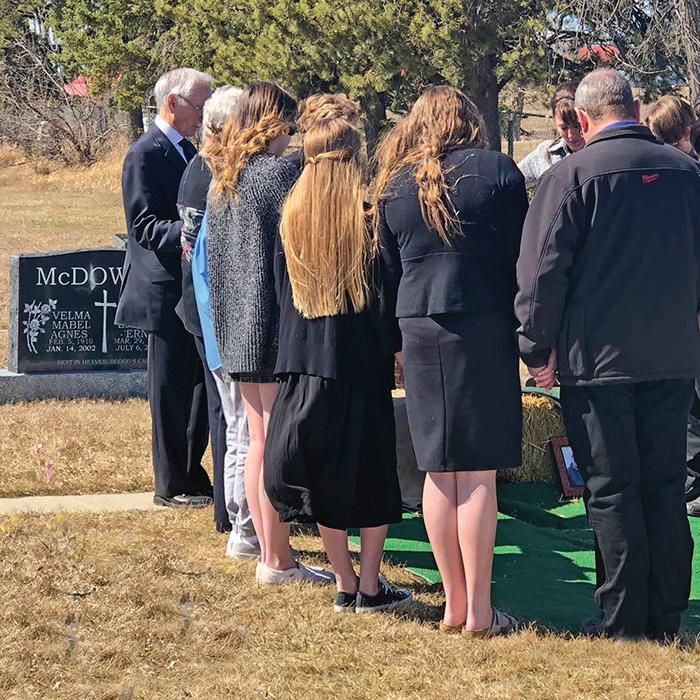
Marlon reports: alternating shifts has allowed us to
As our mission states, Wombold be in compliance with provincial Family Funeral Homes provides caring, expectations. We are able to clean and personalized, disinfect between and professional visits, and remain funeral-related available for service services tailored should any of our to the needs of staff become ill or families of all faiths require quarantine and cultures. In due to possible addition to offering COVID-19 the facilities and exposure. care needed, we Meeting with offer guidance, families to advise, information, and plan services, and advice to grieving offer emotional families and communities. The current Prior to COVID-19, this family would have anticipated more than 500 attendees. care has been particularly challenging. We restrictions placed on public gatherings repurposed space in conference rooms during the pandemic have seriously so that we are able to meet social affected and altered many of our distancing requirements. But we still normal practices. To begin healing after have to limit the number of family experiencing loss of a loved one, it is members physically present, so we are helpful for family and community offering and utilizing video
The 1918 flu pandemic infected half a billion people around the world, including on remote Pacific islands and in the Arctic, killing 20 to 100 million.

their innate curiosity, engaging their parents, and promoting optimum learning by collaboratively developing a personalized learning program for each student.”
We found that this mission can be fulfilled—even during a pandemic.
Marlon Wombold
Owner/Director, Wombold Family Funeral Homes
Following graduation from Parkview Adventist Academy (PAA), Marlon Wombold attended Burman University (then Canadian Union College [CUC]). A few years later, in 1994, he established Wombold Family Funeral Homes in Central Alberta.
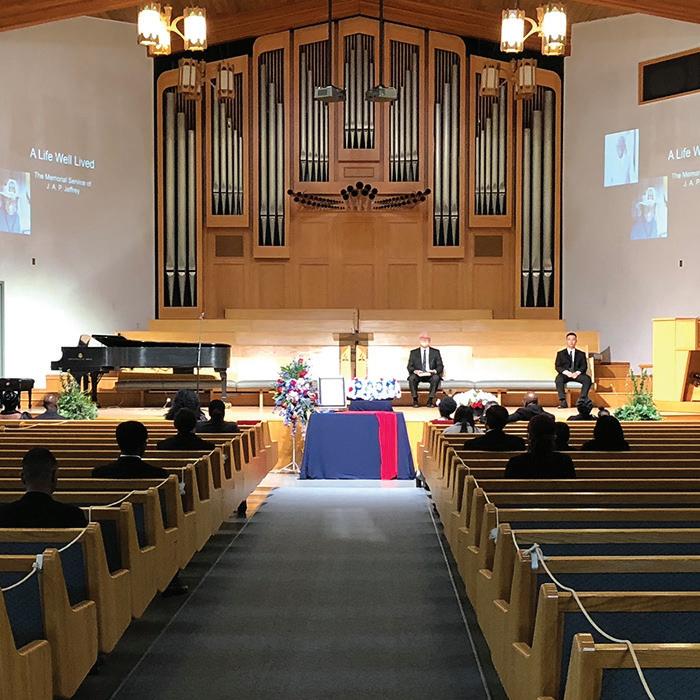
members to come together. But social conferencing, which allows anyone distancing requirements meant that we wishing to participate in planning to do had to develop new so remotely. avenues for people Facilitating to grieve losses, meaningful share pain, and ceremonies while receive the needed adhering to strict support. guidelines and
To begin with, requirements we are required to specifically limit the number designed to keep of individuals in people apart and the facility at any isolated from given time. In each other (from the past, we were 15 participants at always open to first to 50 and now the general public. Fifty mourners are physically distancing to 100) also took Controlling public access by meeting at a funeral service held at the College Heights SDA Church. adjustments and careful planning. with people by appointment only We are meeting this challenge by and by separating our staff into offering families the option of having
services live streamed from our an extended time when many of their chapels so that more people are able to regular duties have been drastically participate remotely. modified or even eliminated due
Some families to provincial are deciding to regulations. postpone funeral Implementing a ceremonies until creative action plan, restrictions are and the commitment lifted. To help and cooperation these families, we of all our staff have created uniquely helped us maintain individual our staffing levels. memorial spaces We know that this in our chapels has not been the where families case recently for may come to many companies and spend time in employees, and all remembrance. Full PPE gear ensures the safety of all of us feel blessed to
Each space has employees, including Director Marlon be able to continue a framed portrait Wombold (pictured here). serving the families of the deceased, the urn (if cremation who come to us for help during this was chosen), and personal mementos unprecedented time. provided by families. These spaces are While the pandemic has not claimed available to families, by appointment, as many lives in Western Canada as it any time day or night. has in other parts of the world, the
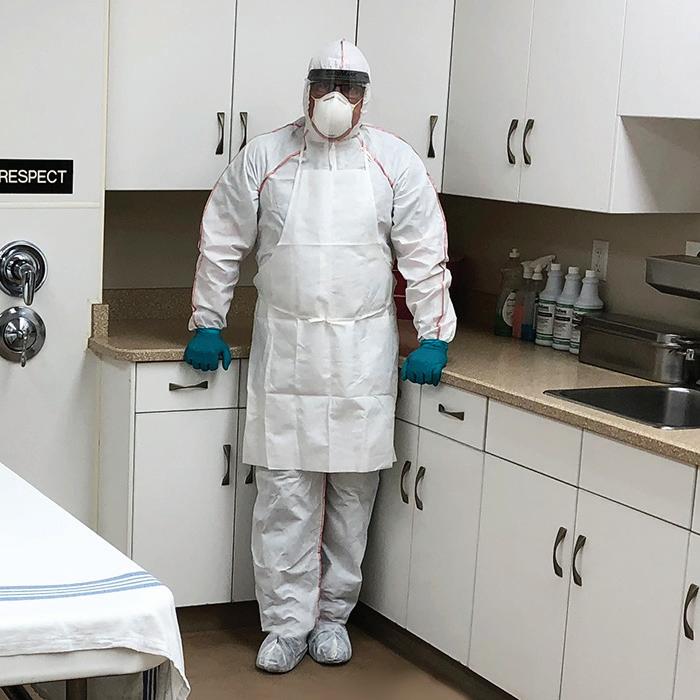
It is also critical to keep our staff (and their families) safe as they care for the deceased who may have been infected with COVID-19. Personal protective equipment (PPE) has always been required for procedures performed at funeral homes. However, implementing its mandatory use in all situations created a number of new challenges. Due to the global demand, we experienced PPE supply challenges, but so far, we have been able to navigate that successfully.
In addition, our staff must now utilize full PPE gear to transfer the deceased from the place of death. When the death occurs at home, this can be very unsettling for family members who are present.
Finally, we are facing the challenge of keeping our staff employed during economic, social and professional fallout is very real.
Royce Odiyar, MDiv, MA
Church Pastor in British Columbia
Royce Odiyar pastors Seventh-day Adventist churches in Revelstoke, Salmon Arm, and Silver Creek, British Columbia. Shortly after completing graduate studies at Andrews University in Michigan, he arrived at his new posting, ready to implement his carefully developed blueprint for getting to know and serve his new parishioners. Six weeks into his new posting, the COVID-19 pandemic hit.
Royce writes:
Six weeks is hardly enough time for moving into a new district, never mind settling into a new home, and then being stopped in one’s tracks by the risk of an invisible enemy. This was completely new territory for me in almost every way. I didn’t know the area, I didn’t know the church and its culture, I hardly knew the members.
My original plan for ministry was simple—do ministry side-byside. In other words, do on-the-job discipleship. Our church is known for training people. We have a seminar for everything. But while at Andrews, I found that the best way to disciple and train is to work with people one-onone while doing ministry together. For example, my visitation plan was to take all who wanted to come and show them how to visit. When COVID hit, this changed everything because now we were being discouraged from close contact with people.
It was obviously impossible to “do church” as usual. The pandemic forced

The most fatal pandemic in recorded history was the Black Death (also known as The Plague), which killed an estimated 75 to 200 million people in the 14th century.
all of us to find new ways of ministering and sharing our love for God with each other and our community. Photo by Keith Phare
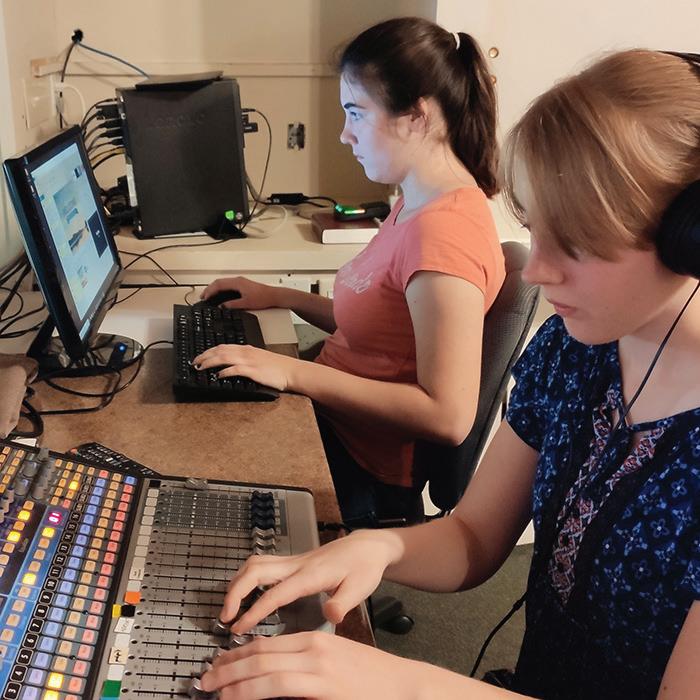
Working with a communications team is a good way to get the youth of the church actively engaged. Pictured above are 11th grade students Jaina Druitt (centre) and Karina White.
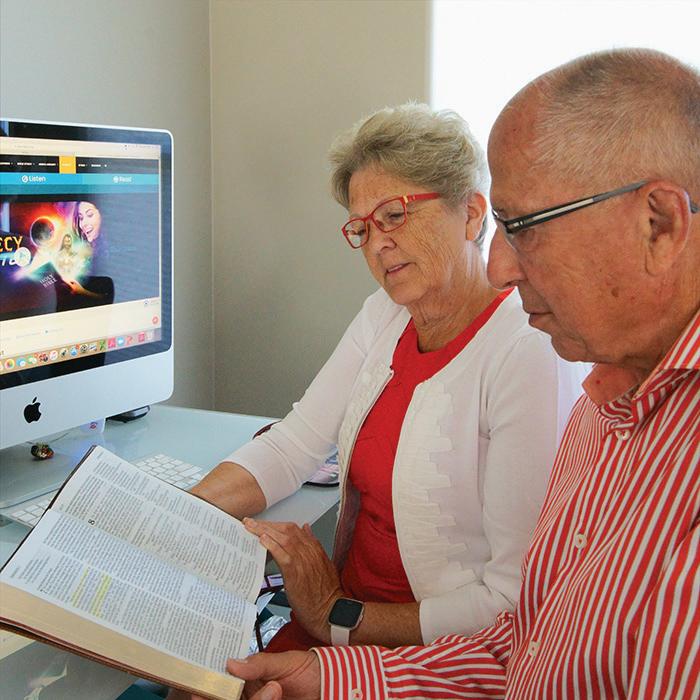
Photo by Ryan Swanson
One of the first didn’t have internet things our church access to watch leaders did was our church series, produce an online to figuring out church service— how to host a not to compete Zoom memorial with other media service, to assisting ministries, but to our Bible worker stay connected with changing with our local from door-tocongregations door ministry to and their specific ministry through needs and prayer social media, to requests. We faced Karin and Peter (HS ‘60) Burman prefer finding solutions challenges such as in-person communication, but in a for families in need rapidly changing pandemic modern technology works well. or for people who information and a had lost their jobs, lack of resources and expertise. to dealing with a host of other issues.
The good news for me was that Remarkably, with a great group of while at Andrews University, I had leaders and a lot of hard work—like taken a double degree: a Master of making phone calls and phone calls Divinity and also a Masters’ degree in and more phone calls, plus hosting a communications. Within this second 10-day running challenge—we started degree, I had had several classes in to see results. With God’s help, we are film production. These taught me the managing to help our church family sustainable pace regardless of what new crisis presents itself daily.
We are experiencing challenging times and walking in uncharted territory, but we are learning that we can work together not only to support each other, but also to serve those around us—including our own families.
Alumni Contributors
Loy Anderson, MD HS ‘87
Sheldon Thunstrom, MAIS, CCP HS ‘88

Fatalities alone don’t account for the full effects of a pandemic, such as absenteeism or the demand on healthcare services.

importance of story and also some basic stay connected. Another huge blessing, technical skills. giving us a much-needed boost, is
So as quickly as possible, I took the seeing our Bible worker’s social media opportunity to invite some of the youth efforts miraculously bring results. in our church to But this learn how to edit reflection would be videos. Organizing incomplete if I did and training them not mention the took a lot of work, toll that COVID-19 but it was amazing takes on my family. to see how quickly Pastoral ministry, they caught on. The even without a kids were not only global crisis, can be a lot of fun to work damaging enough with, but they were for spouses and a big help. children unless
There are many boundaries are other challenges that range from helping church Ensuring a good balance between work and family is especially critical for those in the helping profesions. in place. It has become absolutely essential for me to members who set a healthy and
Karen (Krause) Dunbar, MEd, PASC HS ‘89, U ‘92
Marlon Wombold HS ‘86
Royce Odiyar, MDiv, MA U ‘05

